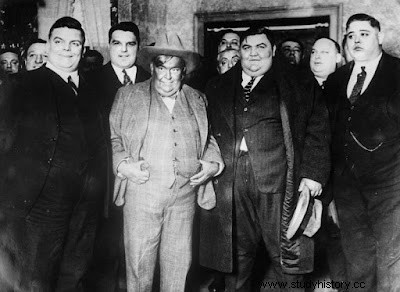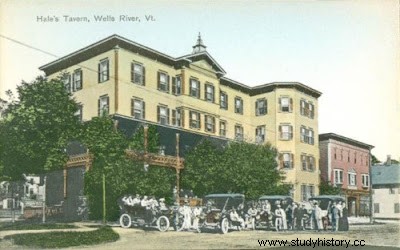 Members of the New York Fat Men's Club in 1930. Source:Npr.org.
Members of the New York Fat Men's Club in 1930. Source:Npr.org.Although the one that achieved the greatest fame in Europe was the Parisian Club de los Cien Kilos (Club des Cent Kilogs ), whose name already made the requirements to enter clear, was not the first. The French opened its doors in 1896, but almost three decades earlier, in 1869 the first one was founded Known for:The Fat Men's Club of New York .They quickly spread throughout the United States under different names (Fat Men's Club, Jolly Fat Men's Club, United Association of the Heavy Men...) and finding their greatest acceptance in Texas . But it didn't take long for the phenomenon to reach places as distant as Serbia, United Kingdom or the aforementioned case of France .But where does all this come from? Well, as they say, there have always been classes, and as was the case in previous times, in the 19th century a plump body used to be synonymous (apart from various pathologies) of an idle life and access to abundant resources. So if it was common for the upper classes to have a larger girth, inevitably the thickness of a person was associated with the thickness of their bag and, perhaps more importantly, to his agenda Thus, these clubs became meeting places for wealthy and influential men who used the occasion to socialize and network . But, beware, without losing sight of the celebration of the size of their bellies. That's how clear that first club founded in New York made it clear:"We're fat and we're making the most of it! ".Be part of a club with these characteristics it was, therefore, a symptom of prestige And it opened many doors for you. And, furthermore, they didn't have a bad time:meetings were organized that, according to the club, were annual or more frequent, and shows were held there. of different types, highlighting above all the boasts when weighing in public. They also came to organize leisure and cultural activities such as excursions and trips, and in fact we have the testimony that the French filmmaker left us from a Parisian club excursion. But the members' favorite part was the big banquets starring excess:seafood cocktails, soups, steaks with all kinds of sauces, roast suckling pigs, pastries filled with all kinds of meats and the most varied desserts.
To enter them there were only a couple of requirements :Pay a monthly payment of approximately one dollar and weigh more than 100 kilos . Then you were given a password and you already had access to those parties and feasts. In some clubs there was even a secret greeting with which the members identified themselves. oh! And being a man … There were specific clubs for fat women , but these were not so well received. Already towards the end of the 19th century, female fat was not seen the same as male fat. When in 1903 the Fat Men's Club was founded in Vermont , the requirement for entry was lowered to 90 kilos. Perhaps this should have been understood as the twilight of fat clubs, however, it was precisely the one in Vermont that had the largest number of members , reaching almost 10,000 at its peak.
 Headquarters of the Vermont Fat Men's Club in 1903.
Headquarters of the Vermont Fat Men's Club in 1903.Source:The New England Historical Society.
However, just twenty years later, in 1924, the Vermont had to close due to lack of members like so many other clubs in the twenties of the 20th century. It was precisely the economic prosperity of the Roaring 20s that put an end to them . And although it may seem like a contradiction, it is not:the economic boom gave rise to a greater purchasing power of the middle classes and imposed a new way of life and a new society based on consumption. Now more people could afford to buy a car, spend the summer or have appliances, but also eat more. Obesity was no longer something reserved for the rich , practically anyone could be fat, so belonging to these clubs was no longer a sign of prestige.
- Segrave, Kerry (2009). Obesity in America (1850-1939). A History of Social Attitudes and Treatment . McFarland.
- (2020) “The New England Fat Men’s Club”, in New England Historical Society .
- Basu, Tanya (03/20/2016). "The Forgotten History of Fat Men's Clubs," at NPR.org .
- Wood Choker, Pedro (2016). Diseases that changed history. The Sphere of Books.
